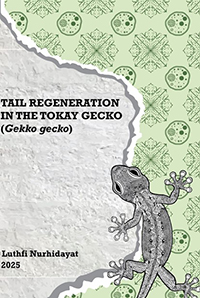
A tail with a twist: how the tokay gecko grows a completely new body part
When the tokay gecko loses its tail, a new one grows from resident stem cells at the stump. Each tissue type - muscle, bone, blood vessels and skin - develops from specific stem cells. This discovery by Luthfi Nurhidayat holds potential implications for advancing regenerative medicine in humans. Nurhidayat will defend his PhD thesis on 9 January.

With many plants, you can simply cut off a piece, and it will grow new roots, forming a new individual. The ‘old’ plant experiences no harm and continues to grow. In animals, however, the so-called regeneration of damaged or lost tissue is much more challenging. One of the most extreme examples is the velvet worm, which Japanese researchers found can shed nearly its entire body, and regenerate fully from just its head within three weeks.
In humans, only a small part of a fingertip can regenerate if it’s lost
Vertebrate animals are far less adept at regeneration than some invertabrates. In humans, only a small part of a fingertip can regrow if lost. The liver does regenerate if part of it is removed, but researchers disagree on whether this is true regeneration or simply normal growth. Male deer provide one of the most remarkable examples of regeneration among mammals, growing a new set of antlers every year – but this is limited to bone tissue. Lizards take it a step further: they can shed their tails to distract predators, then regrow a new tail complete with bone, muscle, and skin tissue.
‘By studying regeneration in different species, we may discover mechanisms that we could apply in humans.’
Doctors are eager to learn from animals how to encourage regeneration in humans. Hence, scientists are keen to uncover the secrets. One of them is Luthfi Nurhidayat, a biology lecturer and researcher at the Indonesian Universitas Gadjah Mada. ‘We see both similarities and differences in how animals regenerate organs or body parts. By studying regeneration in different species, we may discover mechanisms that we could apply in humans.’
The tokay gecko grows a new tail
Nurhidayat studied tail regeneration in the tokay gecko (Gekko gecko), a lizard species. In Indonesia, he established several gecko colonies. ‘I took samples from their regenerating tails at seven different stages of growth.’ In Leiden, he analysed the samples. Nurhidayat discovered that resident stem cells at the end of the stump were responsible for the growth of the new tail.
Nurhidayat: ‘Apparently, a lizard can regenerate complex tissue, such as bone, blood vessels, and skin, simply by activating the resident stem cells. This might also explain why the new tail is not an exact copy of the original one.’ The tail the gecko develops as an embryo grows through a different mechanism. ‘This tail does not originate from various types of specific stem cells, but from a growth zone consisting of so-called pluripotent stem cells. They can differentiate into several types of tissue on the tail.’

'When students nod because they understand, that's so rewarding'
Nurhidayat thoroughly enjoyed his PhD research. ‘Not just the research itself, but also the coffee or lunch breaks where we discussed all sorts of things with colleagues. The track gave me much perspective, not just as a scientist but also as a person. I love teaching, so I especially enjoyed guiding students and assisting them with practicals. When students nodded to show they understood my explanation, it was very rewarding.’
Will we be able to regrow muscles or cartilage in humans in the future?
Nurhidayat finds it promising that stem cells from different tissues can be activated to restore complex structures. 'Stem cell growth also occurs in humans, so this seems like a relevant strategy.'
Perhaps the tokay gecko can help us understand how to activate stem cells to regenerate muscle or cartilage in humans. There is already a lot of research on how stem cell therapy can help regenerate human tissue. ‘For example, the first patient with type 1 diabetes recently started producing insulin again three months after a transplant with reprogrammed stem cells. Stem cell treatments are also already in use or in advanced clinical trial for conditions such as MS, leukemia, and osteaoarthritis.’

Luthfi Nurhidayat defends this thesis titled Tail Regeneration in the Tokay Gecko (Gekko gecko) on 9 January 2025 in the Acadamy Building. His promotors are professors Michael Richardson and Herman Spaink.
